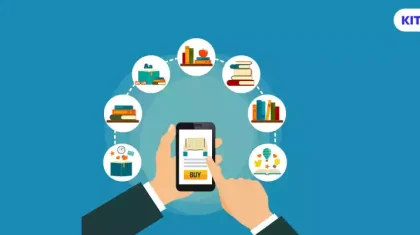
eBook DRM: Protect Your Digital Content Effectively
Summarize this blog with your favorite AI:
In the predominant digital world of today, safeguarding sensitive digital assets like eBooks, PDFs, and various documents, as well as video files, stands as a significant challenge.
Digital Rights Management (DRM) is one of the solutions to this problem. Using DRM, organizations and content creators can control and protect their digital assets from unauthorized access, distribution, and copying. It not only ensures the protection of intellectual property but also provides a mechanism for content creators and distributors to monetize their digital offerings.
Read on as we explore the intricacies of DRM, its workings, advantages, best practices, and more.
Table of Contents:
I. What Is DRM, and Why Do You Need It?
III. Benefits of DRM for eBook Security
- Protection from Piracy
- Authorized Distribution Channels
- Control over eBook Usage
- Potential to Increase Revenue
- Improved Data Security
What Is DRM, and Why Do You Need It?
DRM, or Digital Rights Management, is a technology that helps protect digital content from unauthorized use and distribution. It prevents the creation and sharing of duplicate copies of digital content.
Digital Rights Management solutions come in different variations and can be configured to meet the specific needs of a business. It can also be used to manage how a user gets to access content through a subscription or rental mode.
Given the nature of the internet, where files can be freely downloaded and shared, DRM becomes essential. Without this protection, it becomes challenging to publish and market digital content for sale to businesses and consumers.
KITABOO is a digital textbook platform that offers DRM solutions to safeguard digital content. This way, it ensures that digital content, especially ebooks, is protected from unauthorized use and distribution.
How Is DRM Implemented?
Here’s how DRM is implemented to secure digital content:
Encryption of Data
The foundation of DRM technology is encryption. Certain algorithms are applied to encrypt the DRM-protected eBooks, making them inaccessible without the proper decryption key. This safeguards the file from unauthorized access by individuals lacking the necessary decryption key.
License and Authorization
To regulate access to protected digital content, eBook Digital Rights Management makes use of licensing and authorization mechanisms. To gain access to protected files, users need to procure a license or permission from the creator or publisher of the content. This access can be provided in the form of online authentication, digital certificates, or license keys.
Permission and Access Control
Content creators can develop access control policies for their eBooks using DRM systems. These policies will dictate who can access the content, what kind of permission they might have, and under what conditions they will be applicable. Examples of access control include access limited by time, restricted options for viewing or printing, and the use of passwords.
Tracing and Watermarking
Watermarking is one of the strategies used by DRM systems to reduce the unauthorized dissemination of eBooks. Watermarks can contain information, such as the details of the creator or publisher. It may also have information regarding the user’s transaction details, which can be used to determine the source in case the digital file is leaked illegally.
Benefits of DRM for eBook Security
Here are the most significant benefits of implementing DRM to secure digital content in 2024:
Protection from Piracy
By using eBook DRM, you will be able to drastically reduce the risk of your eBook being copied and distributed illegally, which helps you retain the revenue that comes from sales.
Authorized Distribution Channels
With the help of DRM, your eBook will be distributed to users through a secure distribution channel. This will ensure that only legitimate eBook readers gain access to your eBook.
Control over eBook Usage
Ebook providers will be able to set the rules surrounding the usage of an eBook using DRM. They can provide uninhibited access or temporary access to the eBook as required, thereby offering convenience while protecting content at the same time.
The services related to an online eBook store offered by KITABOO, a distinguished digital textbook platform, enable eBook providers to exert control over the usage rules.
Potential to Increase Revenue
In digital publishing, a lot of revenue can be lost due to unauthorized copies of an eBook distributed for free. Ebook Digital Rights Management helps in retaining revenue that will otherwise be lost to piracy. This revenue can then be employed to produce more high-quality eBook content.
Improved Data Security
Unlike traditional data security, which usually uses credentials and multifactor authentication (MFA) to lock down files, eBook DRM adds an additional layer of protection that can limit the extent of the access and permissions available to the user, even though they might have the proper credentials.
DRM Best Practices to Check Out
Companies must ensure that DRM is implemented effectively so that it is on par with the company’s needs while at the same time not hampering the user experience. A DRM that is not effective enough might push users towards piracy or other illegal methods to obtain the eBook.
While developing a DRM strategy for your business, the following practices should be considered:
- Recognize Internal and External Customers: If DRM makes it harder for users to utilize DRM-locked content, the company may need to provide incentives to keep them utilizing it.
- Create a Sophisticated Strategy: It’s possible for a firm to give some content without copyright protection in exchange for advertising or lead generation.
- Be Ready for the Drawbacks: If a user’s access to something they already possess is restricted in any way, putting DRM on eBooks they have purchased could make their experience unpleasant.
- Give Importance to Scalability: Make decisions with the company’s growth and its DRM solutions in mind at all times.
Final Words
As the demand for eBooks continues to rise, prioritizing the enhancement of eBook security becomes paramount. Implementing strategies to safeguard the rights of authors and publishers becomes more crucial in this age.
The adoption of eBook Digital Rights Management serves a dual purpose: protecting intellectual property and establishing control over content usage and distribution.
Teaming up with a robust digital textbook platform like KITABOO ensures a secure reading experience for your readers. With efficient DRM solutions, the platform not only safeguards intellectual property but also grants you control over how your content is used and distributed.
Connect with us for more info!
Discover how a mobile-first training platform can help your organization.
KITABOO is a cloud-based platform to create, deliver & track mobile-first interactive training content.


